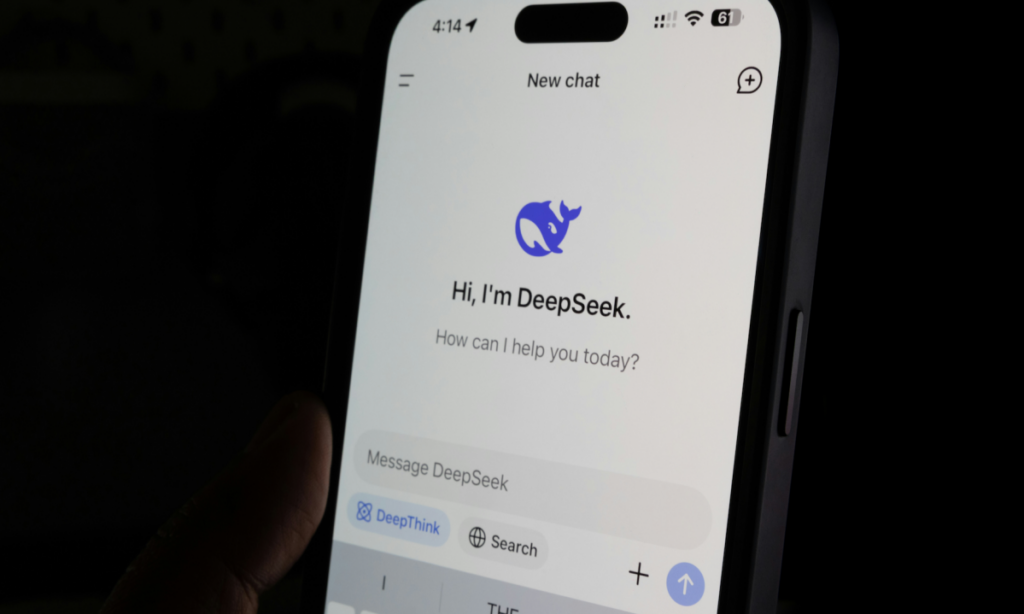
Just a few years ago, AI felt like something out of a sci-fi film – complex, expensive and a bit intimidating. Today, I used an AI tool to summarise the transcript of a long meeting into bite-sized, actionable chunks. It’s become an intrinsic part of my working life. More recently, however, AI technology has started going beyond business-focussed applications.
A friend of mine who always struggles to remember his passwords is using an AI app to organise his entire life. Even my Gran is getting in on the act, using ChatGPT‘s voice feature to get recipe advice whilst cooking a new dish.
This is AI democratisation, manifest. And it’s happening at lightning speed. It’s 2025, and the AI revolution isn’t just for tech giants anymore; it’s impacting all of us. But, are we ready for it? This is more than being excited about cool new tech; it’s about a fundamental shift in how we live and work. It’s also a shift that’s raising big questions about power, access and the kind of future we want to build.
So, what’s all the fuss about “AI democratisation”? Simply put, it means AI is no longer the sole preserve of big corporations and people with technical knowledge. It’s becoming accessible to everyone – small businesses, individuals, even your neighbour who still can’t figure out how to set up their Wi-Fi.
2025 is a pivotal year. User-friendly AI tools are exploding onto the scene, open-source platforms are levelling the playing field, and there’s a global race to develop and deploy AI, making it cheaper and more readily available than ever before.
This democratisation is great news for innovation, but it’s not without its challenges. We’re talking about potential job displacement as AI takes over routine tasks, the risk of algorithms perpetuating harmful biases, and the ever-present worry about data privacy. These aren’t just abstract concerns; they’re issues that will affect our jobs, our businesses, and our society.
Getting to grips with AI’s implications now is crucial if we want to shape a future where this powerful technology benefits everyone, not just a select few.
The AI Landscape – A Global Battleground
The race to develop and deploy AI has evolved from a marathon to a global sprint, with tech giants and nations vying for dominance. This intense competition is driving two key trends: the aforementioned democratisation and a significant shift in the global AI power dynamics.
For businesses, this means a whole new world of opportunities to innovate and compete. For individuals, it means new tools to boost productivity, learn new skills and even tackle everyday tasks. But it also means we need to be aware of the risks and ensure that AI is developed and used responsibly.
The Democratisation Race: Google’s Wager and the Rise of Open Source
The battle for AI supremacy used to be a space race to build the most powerful models. Now, it’s about making them accessible to the masses. Google is aggressively pursuing this democratisation strategy, positioning AI as an everyday utility.
Their heavy push of adverts showing Gemini 2.0 being used for casual, everyday tasks is a clear sign of this. They’ve made AI so user-friendly that even the most technophobic folk can find a practical or fun use for it.
They’ve also integrated Gemini 2.0 with their applications, including Docs, Sheets and Maps. Their self-proclaimed “Chief Simplifier Officer” is helping users automate workflows, unify data from various marketing platforms, and even generate creative content like “shoppable video ads.”
In Google Docs, Gemini 2.0 helps users by generating content based on prompts, aiding in the creation of reports, emails, and other documents. Within Sheets, Gemini 2.0 can analyse datasets, generate insights, and even create visualisations, simplifying complex data interpretation. In Maps, Gemini 2.0 offers personalised recommendations for routes, places of interest, and travel plans, enhancing user experience.
Gemini 2.0 even extends its capabilities to smart home devices, allowing users to control their home environment through natural language commands. This promotes a more intuitive interaction with AI technology in the vein of Amazon’s Alexa or Apple’s Siri.
What’s more, Google’s AI-powered ad tools, like Performance Max, are revolutionising digital advertising by automatically allocating budgets and creating tailored ad copy, making sophisticated marketing accessible to even people without advanced technical knowledge.
This means even small businesses can now compete with the big players, using AI to reach their target audience more effectively.
The Open Source Uprising
But it’s not just about the big tech companies. The open-source movement has been instrumental in making AI tools accessible to a broader audience. By providing free access to AI frameworks and models, open-source platforms empower individuals, research institutions, and companies to muck in, adapt, and innovate on existing technologies. T
This collaborative approach accelerates advancements and ensures that AI development isn’t confined to well-funded entities alone.
Several open-source platforms have made significant contributions to AI democratisation:
TensorFlow: Developed by Google, TensorFlow is an open-source framework that has become a cornerstone for machine learning research and application development.
PyTorch: Backed by Facebook’s AI Research lab, PyTorch offers a flexible platform for deep learning research, widely adopted in both academia and industry.
Hugging Face: This platform provides access to a vast repository of pre-trained models and datasets, facilitating natural language processing tasks and lowering the entry barrier for AI development.
These platforms are levelling the playing field, allowing anyone with a decent internet connection to experiment with AI.
This is a game-changer for innovation, opening up a world of possibilities for developers, researchers, and entrepreneurs worldwide. But it also means we need to be extra vigilant about the potential misuse of these powerful tools.
A New Contender? DeepSeek’s Challenge
DeepSeek, a Chinese artificial intelligence company, has emerged as a formidable competitor in the AI landscape with its R1 model. Founded by Liang Wenfeng in 2023, DeepSeek focuses on developing open-source large language models. The R1 model, released on January 20, 2025, is designed for advanced reasoning tasks and has been made fully open-source under the MIT license, allowing for free use and modification.
DeepSeek claims to have achieved performance at only 10% of the cost of training a model like GPT-4o, using only 2,000 Nvidia H800 chips. This is significant because H800 chips are less advanced than the top-of-the-line chips that U.S. companies have access to, due to export restrictions.
DeepSeek’s innovative “Dynamic Value Topology Network” architecture even incorporates ethical considerations directly into the AI’s decision-making process, addressing the common challenge where increasing a model’s performance can sometimes lead to unintended negative consequences.
This cost-efficiency breakthrough demonstrates that groundbreaking AI development doesn’t necessarily require massive budgets or the most advanced hardware, challenging the prevailing assumptions in Silicon Valley.
The introduction of DeepSeek’s R1 model has been described as AI’s “Sputnik moment,” signalling a significant shift in the global AI landscape.
This is a wake-up call for Western tech companies, showing that innovation can come from anywhere and that the race for AI supremacy is far from over. It also means that more affordable AI solutions could be on the horizon, further accelerating adoption – but also potentially increasing competition and the need for businesses to adapt quickly.
The Infrastructure Arms Race: Stargate, ByteDance and NVIDIA‘s Power
A key part of the AI revolution is the physical infrastructure that powers these systems. This has led to a new kind of arms race, with nations and tech giants making massive investments in AI infrastructure.
The Stargate Project, a joint venture between OpenAI, SoftBank Group Corp., Oracle, and MGX, is a major sign of this. With plans to invest up to $500 billion in AI infrastructure across the United States by 2029, Stargate aims to establish numerous large-scale data centres and create over 100,000 jobs, positioning the U.S. as a global leader in AI.
This project, often compared to the Manhattan Project in scale and ambition, signifies a major commitment by the U.S. to maintain its leadership in AI.
Meanwhile, ByteDance, the parent company of TikTok, is also making significant strides, planning to invest over $12 billion in AI infrastructure in 2025. This includes $5.5 billion for AI chips in China and $6.8 billion to enhance model training capabilities using Nvidia chips internationally.
These massive investments reflect a global battle to be at the forefront of AI, with nations and major tech companies fighting for technological and economic dominance.
At the heart of this infrastructure boom lies Nvidia, the leading semiconductor company providing the hardware that powers most AI systems. With a market capitalisation exceeding $2 trillion as of March 2024, Nvidia’s GPUs have become essential for training and running complex AI models.
Their continued dominance underscores the importance of hardware innovation, particularly in semiconductors, for the advancement of AI. This highlights a crucial point: the AI revolution is also about the physical hardware that makes it all possible. And for businesses, it means that staying ahead of the curve requires understanding the entire AI ecosystem, from the chips to the algorithms.
The Implications of Democratisation: AI for Good and the Rise of the Agents
The democratisation of AI, coupled with the intensifying global competition, has far-reaching implications. When it comes to AI, it’s important to remember that with great power comes great responsibility.
Increased Innovation: Wider access to AI tools will fuel innovation across all sectors. Small businesses and startups will be able to leverage AI to develop new products and services, compete with larger companies, and disrupt existing markets. We’re going to see an explosion of creativity as more people get their hands on these powerful tools. But we also need to ensure that this innovation is directed towards solving real-world problems and creating a more equitable society.
Economic Transformation: AI will drive productivity gains, automate tasks, and create new job categories. This will lead to significant economic transformation, requiring businesses and workers to adapt to the changing landscape. While some jobs may be displaced, new roles and opportunities will emerge, particularly for those who can work alongside AI. This means we need to invest in education and training to prepare the workforce for the AI-powered future.
Geopolitical Shifts: The global AI arms race will reshape the geopolitical landscape, with nations vying for technological and economic dominance. Control over AI infrastructure and talent will become increasingly important. This could lead to new alliances and rivalries, as countries seek to secure their position in the AI-powered world. We need to foster international cooperation to ensure that AI is developed and used responsibly on a global scale.
Ethical Considerations: The widespread use of AI raises ethical concerns about intellectual property, bias, privacy and job displacement. Addressing these concerns will be crucial for ensuring that AI is used responsibly and benefits all of humanity. We need to ensure that AI systems are fair, transparent, and accountable, and that they respect human rights and values.
Accessibility for All: Artificial Intelligence is playing a crucial role in developing tools that enhance accessibility for individuals with disabilities. AI-driven applications, such as advanced voice assistants and predictive text technologies, assist users with visual, motor, or cognitive impairments in navigating digital environments more effectively. For example, AI-powered screen readers can interpret and vocalise on-screen content, while speech recognition software enables hands-free control of devices, thereby promoting greater inclusivity.
AI Agents Emerge: AI-powered agents have become increasingly prevalent, serving as partners that assist in automating tasks, streamlining workflows, and solving complex problems. These agents utilise advanced machine learning algorithms to understand context, make decisions, and perform actions on behalf of users.
Final Thoughts
The democratisation of AI in 2025 is a crucial element in a societal transformation. It promises a future where the power of AI is available to everyone, not just a select few. I genuinely believe that we are on the cusp of something extraordinary.
But this future also presents challenges. We need to grapple with the ethical dilemmas, ensure that AI is developed responsibly, and adapt to the changing economic landscape.
Here’s what I think we’ll see in the near future: a growing demand for professionals who understand both the technical and ethical aspects of AI, so get learning now if you want to take part in this once-in-a-generation shift.
What can you do? Start learning about AI now. It is essential that you understand the basics, even if you’re not a techie. Experiment with the new, user-friendly tools that are becoming available.
Share this article, start a conversation, and get involved in shaping a future where AI benefits everyone. The race is on, the stakes are high, and it is up to all of us to make sure this AI revolution is a force for good.










